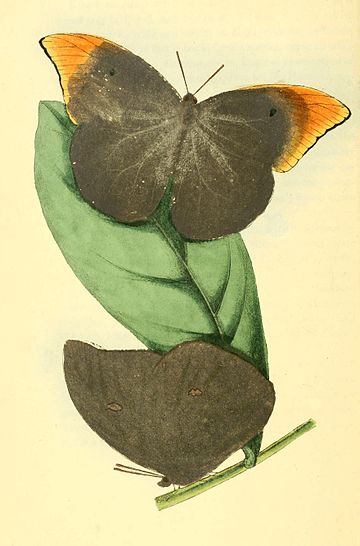Zoological Illustrations/VolI-Pl6

COLIAS Leachiana.
Leachian Colias.
Generic Character.—See Pl. 5.
Specific Character.
- C. alis subrotundatis, integris, virescenti-albidis, anticis supra fulvis, margine punctoque medio nigris, singulis subtus maculâ centrali ferrugineâ. Encycl. Method.
- (Male) wings slightly rounded, entire, greenish white; anterior pair above orange, at their tips, margin, and central dot black: each pair beneath with a central ferrugineous spot. Female ——?
- C. Leachiana. Godart in Encycl. Method. vol. ix. p. 91.
In size this insect is the largest of the genus yet discovered; it was first noticed by Godart, who has given it the name of my learned and valued friend, Dr. W. E. Leach, of the British Museum, whose talents are too well known to need any eulogium in this place.
It appears to inhabit both the northern and southern extremities of Brazil; for I have seen it in a box sent from Parà, and my specimens were captured in Minas Geraes by my friend Dr. Langsdorff. It is, however, a rare species; for I have only seen seven or eight specimens, and they were all males: the female, when found, will probably differ as remarkably as in most of this genus.
The opaque spot on the inferior wings above is very large; but the tuft of hair corresponding beneath the superior wings, is entirely wanting. It should be likewise observed, that although this insect in every outward respect resembles a genuine Colias (the type of which may be C. Ebule), it differs very materially in the terminal appendages of the abdomen; the last joint being the shortest, and scarcely pointed; and the hook, instead of being concealed beneath this segment, is exserted beyond it, and met by two others, one at the base of each lateral valve: these valves are also much shorter, ovate, and not attenuated, although ending in an incurved hook. In the present ignorance in which a true knowledge of the Lepidoptera is involved, it is impossible to say how far these dissimilarities may point out natural groups; it is therefore of the highest importance to the science such facts should be noticed.
